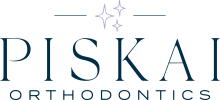Whether you notice alignment issues with your child’s teeth or they look perfectly fine to you, the American Association of Orthodontists (AAO) recommends children have their first orthodontic evaluation by the age of seven. Now, it’s understandable if you feel a little hesitant about taking your little one to the orthodontist early. General perception is that, if needed, orthodontics comes later — in the tween or teen years. And while this is true, it’s also important to check in with your orthodontist earlier.
Rest assured, bringing your young child to Dr. Piskai doesn’t automatically mean your little one will walk out with braces. The team at Piskai Orthodontics takes a conservative approach to phase 1 orthodontics, only recommending it when there’s a clear health benefit. If Dr. Piskai does see issues, phase 1 orthodontics can help improve your child’s quality of life and make braces or Invisalign treatment later on a little easier.
So what exactly is phase 1 orthodontics, you ask. Good question! That’s what this post is all about. In this guide to phase 1 orthodontics, we’ll answer:
- What happens in an early orthodontic assessment?
- How do we know when early orthodontic treatment will help?
- What is phase 1 orthodontic treatment and how does it work?
- What orthodontic appliances can I expect in phase 1 orthodontics?
- How long does early interceptive orthodontics take?
- What are the benefits of early interceptive orthodontic treatment?
What happens in an early orthodontic assessment?
By age seven, children typically have their first permanent molars and incisors in place and the jaw shape that will grow with them is established. In an early orthodontic visit, Dr. Piskai evaluates the growth and development of your child’s teeth and bite. This appointment is also a chance for you and your child to see what an orthodontist’s office is like — ours is a fun place to hang out, and we strive to make every visit a stress-free experience.
If Dr. Piskai sees that your child’s teeth are on-track, this first visit just kickstarts an observational period as they grow. We’ll see your child every year to check on their oral development and let you know if and when it’s the right time to start orthodontics. At Piskai, these free check-ins are efficient and comfortable, with state-of-the-art diagnostic tools supported by our empathetic approach.
How do we know when early orthodontic treatment will help?
On the other hand, Dr. Piskai might see that your child would benefit from early orthodontic treatment if she sees issues like:
- Significant crowding and misalignment with your child’s baby teeth. (Permanent teeth are bigger than their primary teeth counterparts and need more room to come in well-spaced.)
- Early loss of baby teeth due to injury or tooth decay
- Protruding front teeth, which are more susceptible to injury
- Skeletal issues like a severe overbite, underbite, open bite or crossbite (either anterior, or posterior)
- Problems with chewing or biting
- Speech difficulties with pronunciations or speaking clearly
What is phase 1 orthodontic treatment and how does it work?
Phase 1 orthodontic treatment — also called early interceptive orthodontic treatment — does the heavy lifting in addressing the above skeletal and dental issues while your child’s jaw is more easily responsive. You see, when the jaws are fully developed in the teen and adult years, it’s much harder to move them — aligning them could require surgery.
Early orthodontic treatment guides oral development while the jaws are easier to manipulate. Did you know? A child’s upper jaw is still in two halves, which makes it easier to expand than in adulthood when the two sides are already fused together.
What orthodontic appliance can I expect in phase 1 orthodontics?
Typically, phase 1 orthodontic treatment involves a child wearing an appliance like a space maintainer, a palatal expander, or limited braces.
Space maintainer:
Has your child lost a baby tooth prematurely to tooth decay or injury? If so, the resulting space needs to stay open so the adult tooth has room to come in when it’s time. Why? Well, fun fact about teeth: they tend to drift to fill gaps, so if you don’t use a space maintainer, your child’s surrounding teeth might start to crowd into the gap and block the adult tooth’s path. The result is what’s called an impacted tooth.
Space maintainers come in either fixed or removable types. A fixed type typically holds space until the permanent tooth is ready to erupt and is anchored by the surrounding teeth. Regular check-ins ensure that the space maintainer is secure so no space is lost. A removable space maintainer fits into the mouth and stays there for most of the day. Your child can take it out to eat and to brush and floss their teeth. Now, we get it, kids being kids, any removable orthodontic appliance is prone to getting lost or misplaced. So it’s important caregivers help their kids keep an eye on their space maintainers!
Palate expander:
Also called a rapid palatal expander (RPE), this phase 1 orthodontic appliance sits against the palate — the roof of the mouth. It’s a custom-made, stainless steel orthodontic appliance that fits around several of the back upper teeth. A palate expander has two halves (like the two halves of a child’s upper arch) and a screw in the middle you incrementally turn with a tiny key. This action puts gentle pressure on the two palatal bones and widens the jaw.
Once your child’s upper jaw sufficiently expands, their rapid palatal expander stays in place a bit longer but without adjustments. New bone forms and stabilizes the expansion.
The bright side of a wider upper arch? Room for your child’s larger adult teeth so they don’t become impacted or crowded together. A rapid palatal expander also corrects discrepancies between the upper and lower jaw so that the top and bottom teeth come together properly.
Braces:
Braces for young kids aren’t like the ones you typically picture on older kids. Also called limited braces, phase 1 braces are placed only on the teeth that need them. In other words, Dr. Piskai will only bond brackets to certain teeth, not all of them.
Orthodontists use braces in phase 1 orthodontic treatment to correct types of malocclusion (when upper and lower teeth don’t stack together correctly) and straighten misaligned teeth. Sometimes limited braces are recommended if your child has thumb- or finger-sucking habits that have gone on too long and have begun affecting teeth.
The best age for limited braces? They can happen when your child already has a mix of baby and adult teeth, called the mixed dentition phase. Braces can attach to either baby or adult teeth, though baby teeth have shorter roots and might not be able to support more dramatic tooth movements.
How long does early interceptive orthodontics take?
At Piskai Orthodontics, we understand that orthodontics for young kids isn’t always easy on them. Rightly so, they want the freedom to eat what they want without worrying about food getting stuck in their orthodontic appliance. Or have to keep track of one that’s removable and easily misplaced or damaged in the busyness of the day.
Dr. Piskai typically recommends early orthodontic treatment happen between ages 7-10.
With phase 1 orthodontic treatment, we focus on a specific goal and treatment generally finishes in 12 months. Once we reach the goal, your child says bye-bye to orthodontics until phase 2 treatment — if they need it. Phase 2 treatment is your well-known braces or Invisalign® treatment when all adult teeth have grown in.
The benefits of early interceptive orthodontic treatment
Your orthodontist for kids in Cherry Hill recommends early interceptive treatment only if it results in health benefits for your child. When phase 1 orthodontics is necessary, outcomes of this treatment include:
- Guiding jaw growth
- Helping kids avoid the need for corrective jaw surgery or tooth extractions
- Creating the necessary space for permanent teeth to grow in properly
- Stopping harmful oral habits like thumb sucking and tongue thrust
- Making later treatment faster and more affordable
- Helping with chewing, biting, and speaking
- Addressing airway issues like sleep-disordered breathing
- Creating facial symmetry
- And, of course, enhancing kids’ confidence and self-esteem!
Straight, well-aligned and well-spaced teeth can boost your child’s daily life. They can enjoy perks like fewer cavities, easier chewing, better nutrition, and improvements in speech.
Your expert kids’ orthodontics provider in Cherry Hill
Now that you’re super well-informed about the ins and outs of phase 1 orthodontics, Dr. Piskai and our kid-loving team would be happy to see if your child would benefit from early interceptive orthodontics. Or maybe walk with them on their oral development journey and provide braces or Invisalign if needed in future years.
Contact your board-certified South Jersey orthodontist today to book an early orthodontic assessment. We love serving Voorhees, Cherry Hill, Medford, Marlton, Runnemede, Lindenwold, and the surrounding communities of South Jersey.




